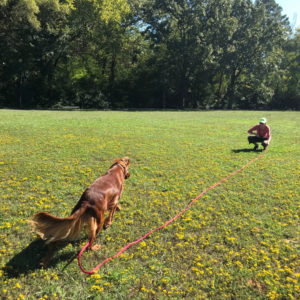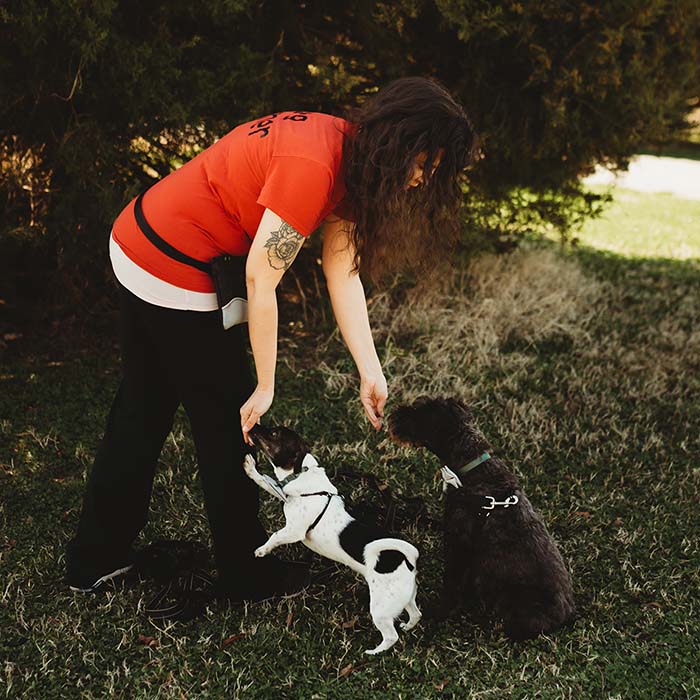Is she aggressive?
Aggressive behaviors and management can be complicated
This past weekend, the dog park was empty until another car pulled up.
I had my dog, Jeeves, and Sonar, a Malinois and German Shepherd mix. Sonar isn’t mine, but we’ve done some training together, and she recently finished her heartworm treatment, so she needed to get out and run. (More on Sonar here.)
Out of the other car emerged a couple, a three-year-old child, and two dogs. One was a fluffy doodle, and the other was a young Golden. Sonar started her signature barking as soon as they approached the gate. She’s been prone to getting loud while trying to play, even before her heartworm treatment. She’ll bark at dogs’ faces, and sometimes she’ll nip at their legs. It’s what I call inappropriate play — dogs should be play bowing, inciting chase by running away, and taking turns. There should be a lot of bouncy, wiggly movement, and Sonar is not bouncy, but she’s also not mean. She’s doing her best, but other dogs don’t always take it that way.
As a precaution and to prevent their very young child from being overwhelmed, I grabbed a hold of her as they came in the gate.
“Is your dog aggressive?” was the first question they asked me.
Aggression is any sign a dog gives to indicate the threat of an attack or an outright attack. In my three years of being a dog trainer, I’ve gotten bitten seriously twice, with just one scar from a dog bite when the dog wasn’t even threatening me. She’d been barking at another dog, reacting to nothing but a hard stare from the other dog.

Often, the dog who reacts to a threat isn’t the dog who started the threat, but we humans have a hard time seeing it. That night in class, I saw the first threat, the hard stare, but the owner of the dog who was reacting was allowing his dog to get closer and closer to the other dog. If they met on leash, it would have been an instant fight. I grabbed her leash to pull her back, and she whipped around on me, sinking one tooth into my arm.
While the entire scenario was an aggressive display between two dogs, I wouldn’t have labeled either one an aggressive dog. There were aggressive behaviors. But a lot of aggressive behaviors can be managed.
My second bite, about a year and a half after the first, happened while I was working at the doggy daycare (more on that here). The dog, who I’ve trained since the bite, is a perfectly nice and friendly dog. He’s stubborn and smart, which can be difficult to manage, and his owners do a wonderful job of staying on top of his behaviors and giving him what he needs to be successful. But he’d developed kennel aggression at the daycare, which meant he barked furiously at any dog kenneled while he was not kenneled. Sometimes it’s the reverse — a perfectly nice dog otherwise turns into a ferocious beast when kenneled. Is that perfectly nice dog therefore an aggressive dog? No. However, he has a specific type of aggressive display that can be properly managed with the right information and handling. Other specific types of aggressive displays can include issues with gates or doors. Cars can sometimes be a trigger for dogs. My sister’s dog, Maslow, absolutely hates white trucks.
At the dog park, I was coming off of a couple of weeks where I’d dealt with quite a few people being touchy about their dogs. I never use the word “aggressive” when talking to people about their dog’s behavior, but they seemed to think somehow that I was considering their dog aggressive.
Suddenly, I found myself being the touchy one. “No, she’s a Malinois Shepherd mix, so she’s a lot of dog,” I explained. “She is not aggressive, but she can be a bit much. If you get uncomfortable at any point, let me know and I will leave.”
“Well, ours aren’t at all aggressive,” she decided to tell me.
Her large fluffy dog then started vocalizing soon after that, because as soon as everyone got into the park, Sonar was acting appropriately and respectfully, but their dog was uncomfortable. As he started barking, they were alarmed: “Oh, he’s never done that before!”
“I’m not worried about it,” I said. But I kept an eye on Sonar. The last thing I needed was for the two to get into a barking match.
She started play snapping soon after, pulling up her lips to reveal her teeth, and I grabbed her to go.
Because even aggressive behaviors dogs can use to indicate a threat can also be used in a perfectly fine manner, like barking or muzzle snapping (depending on the snapping and what else is going on!) or even growling. I’ve explained quite a bit to people that an individual sign doesn’t always mean that much, like a tail wagging. But a hard stare or whale eye, combined with a stiff body, can mean a whole lot. Even a perfectly nice dog who naturally has a stiff body, like English Bulldogs, can be considered a threat to another dog who doesn’t like what they are doing or how they’re playing. Muscular dogs often get into trouble without intending to.
And hackles raised can mean that a dog is uncomfortable or they’re about to attack or they’re overstimulated. Raised hackles are best viewed within the context. If a dog has a super loose body and they’re having a good time, but their hackles are raised, they could simply be overstimulated.
The signs of aggressive dog behavior often start well before us humans can see it.
If you’re not sure about what you’re seeing or how to identify behaviors that should be managed, then:
- Talk to a trained professional. If you’re not sure what you’re seeing or how to manage your dog’s behavior, talking to someone with experience can help. While dog owners often know their dog the best, and they are usually aware of how a dog plays or interacts or if they are yelling just because they are the dog park party pooper, sometimes having an outside eye helps.
- Study dog behavior. If you want to see how nuanced behavior can get, I’ve been learning some new things from The Language of Dogs. (This is not an affiliate link, just something I’ve enjoyed.)
- Let your dog correct. Often a dog will approach another dog and the other dog may snap or bark. The first dog should then listen and walk away from the first dog. I love to see those sorts of interactions because it’s a conversation and a response. Often the dog who is telling another dog that they don’t like what’s happening is the one corrected, which takes away their ability to communicate and can lead to more serious behaviors later on. Huge displays of correction or vocalization might not always be appropriate, however.
- Redirect your dog if they need it. Often dogs have awkward social skills, much like people. They can think they’re playing while they’re actually annoying another dog, which can lead to an aggressive display. I often suggest that young puppies be directed away from much older dogs. Like us humans, older dogs can have very little patience for puppies.
- Remain calm. There are lots of wonderful, pain-free and fear-free tools to manage behavior. Our nerves and fears can sometimes make a situation worse accidentally. The more we can interact with dogs and understand what’s happening, the better of a time everyone will have.

And finally, and probably most importantly, be sure to communicate! Ask the other dog owner if something is normal or if their dog seems to be uncomfortable. Sometimes dogs can be funny about water bowls, toys, or treats. Instead of coming at every dog interaction as aggressive, let’s start asking one another if we can help or what we should watch out for. Ultimately, if you feel unsettled by an interaction or a dog, just take your dog and go.
Telltail Dog Training offers group classes and private in-home lessons in the Little Rock area, along with training walks for current clients. Find Telltail’s podcast here, or find additional information on Instagram, Facebook and YouTube.



